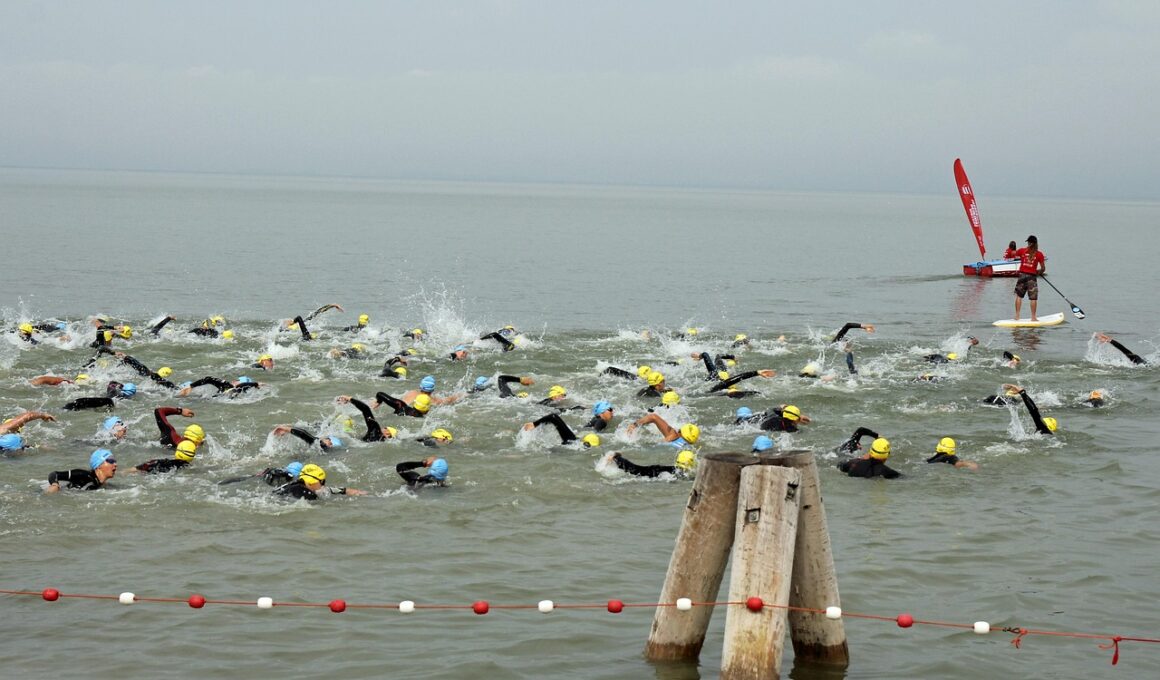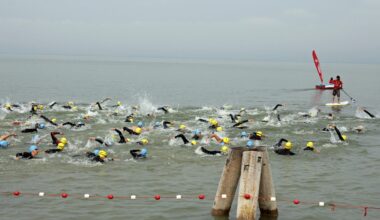How to Dress Appropriately for Cold Water Swimming
When it comes to cold water swimming, choosing the right attire is crucial for comfort and safety. The first consideration is the temperature of the water. Cold water can be defined as anything below 60°F (15°C), and swimmers need to gear up accordingly to prevent hypothermia. A wetsuit is often the first line of defense; it provides thermal insulation by trapping a thin layer of water, which the body warms up. Another exceptional alternative is a drysuit, which keeps you completely dry but may require additional layers beneath. As you prepare for your swim, consider the proper thickness of the wetsuit, as it varies from 2mm to 7mm based on water temperatures. Besides, you must also think about your extremities, as hands, feet, and head lose heat swiftly. Equip yourself with neoprene gloves, boots, and a swim cap to maintain warmth. Special swimming goggles can also enhance your experience and ensure safety in murky waters. Furthermore, layering your clothing when you’re out of the water can dramatically improve your post-swim experience and keep you comfortable.
Essential Equipment for Cold Water Swimming
To truly enhance your cold water swimming experience, focusing on essential gear is necessary. The right equipment not only provides warmth but also confidence in handling chilly and challenging environments. One must start with a high-quality wetsuit or drysuit that fits snugly. A snug fit reduces water flow, which helps maintain body heat effectively. In addition, prioritize a well-fitted neoprene swim cap, as it can retain approximately 20-30% of body heat lost through the head. Don’t underestimate the importance of swim gloves and boots; they are designed to protect the extremities from the cold water. For visibility and safety, consider wearing a brightly colored swim buoy or a rash guard, especially in open water. These accessories offer flotation and help you stand out to other swimmers or boaters. Another significant piece of gear is swim goggles designed for cold weather, which often feature antifog technology. This minimizes discomfort and allows for a clearer view beneath the water surface. Investing in quality gear will enhance the overall experience and safety during your cold water swimming adventures.
When dressing for cold water swimming, layering techniques can significantly impact comfort levels. Start with thermal base layers underneath your wetsuit or drysuit to maximize heat retention. Consider investing in thermal rash guards or tops specifically designed for swimming activities in lower temperatures. These pieces not only provide insulation but also protect the skin from abrasions and the elements. Ensure your undergarments are moisture-wicking to pull sweat away from your body, which is vital in maintaining warmth. Pay special attention to your legs; thermal leggings or shorts can offer additional insulation, particularly during long outings. Choosing the right fabric is critical; materials like neoprene and polypro are great for keeping you warm without adding excessive weight. Focus on layering your top half as well, incorporating a thin thermal layer under your wetsuit for another level of added warmth. However, be mindful of over-tightening layers, as it might restrict movement. Experiment with various combinations to find the best setup for your body type. Regularly monitoring your body temperature is essential, so know your limits and adjust layers accordingly to maximize comfort and safety.
Techniques for Heating Up Pre-Swim
Proper preparation prior to entering cold water can play a crucial role in performance and safety. One effective technique is performing dynamic warm-up exercises. Engaging large muscle groups increases blood flow and raises your body temperature, which can help mitigate the shock of cold water. Simple exercises like arm circles, leg swings, and jumping jacks can effectively circulate blood. Another great tactic involves practicing your breathing techniques; controlled breathing can reduce anxiety and prepare your body’s reaction to the cold. Consider immersing yourself gradually in cold water, allowing your body to acclimatize. Ramping up slowly helps your body adjust to the changing temperature regime. Techniques like this also prevent sudden shocks that could disrupt performance. Packing a warm-up kit with equipment like hot packs can enhance your pre-swimming ritual. Place them on your neck and back to increase overall warmth. After your swim, implementing cooldown procedures, such as light stretching, is equally essential. This practice assists in returning your heart rate back to normal and stabilizes your body temperature post-swim.
Timing is another critical factor when dressing for cold water swimming. Knowing when to go for a swim can significantly impact your performance and safety. Ideally, the temperatures are much warmer in late spring or early summer, making them ideal for cold water swims. Ensuring a swim buddy is nearby can be advantageous as well. It’s always wise to swim with a partner; in case of difficulties, having someone close can be incredibly reassuring. Additionally, being aware of the weather predictions and tides can help to plan your swim effectively. Always check for water temperature and currents before heading out as these elements can greatly influence comfort levels. A swim user review application can provide insights based on experiences of locals and fellow swimmers. Furthermore, slowly acclimatizing your body to cold water can be beneficial through short, controlled-period swims or cold shower sessions leading up to your swim. This practice can help minimize performance anxiety while boosting confidence, ultimately preparing your body for the next swim session. Learning to listen to your body is crucial, so make thoughtful decisions regarding when and where to swim.
Post-Swim Care and Recovery
Once you have successfully completed your cold water swim, post-swim care becomes essential. After experiencing colder temperatures, your body needs to recover adequately to prevent post-swim complications like hypothermia. Start the recovery process with immediate rewarming; utilize insulated jackets, blankets, or cozy towels. Every degree counts, so wrapping yourself in warmth during the transition is incredibly significant. As you warm up, make sure to hydrate, as dehydration can occur even in cooler temperatures. Drink warm beverages like herbal teas or broths, as they can promote blood circulation and provide comfort. Following this, consider refueling your body with nutrient-rich snacks or meals, consisting of carbohydrates, proteins, and healthy fats. Foods like nuts, energy bars, and whole grains provide essential resources that your body craves after such an event. Taking a warm shower can also be a comforting step in the recovery process. Ensure you don’t stay in the shower for too long, as excessive moisture can lead to skin irritation. Monitor your bodily responses after the swim to determine any necessary adjustments to your attire or routines for future swims.
Ultimately, keeping a positive mindset is vital when preparing for cold water swimming. Embracing the unique challenges of swimming in lower temperatures can enhance personal growth opportunities. Every swimming experience is a lesson, so maintain a curious and adventurous spirit. Familiarizing yourself with the local swimming community can also provide supplementary motivation, insights, and tips on safely enjoying cold-water activities. Join swimming forums or local groups to keep up-to-date with best practices and equipment updates. Furthermore, keeping track of your progress by logging your swimming experiences is encouraging and can help you set new goals. Celebrate small achievements, such as increased swim durations or improved comfort levels. Each swim attempt allows the chance to reflect on what works and what does not. This helps fine-tune your approach to cold water swimming, combining technical skills with an enthusiastic mindset. Be sure to capture memories through photographs, so share your experiences and inspire others to embrace this exciting facet of swimming. Finding joy in the process and making friends along the way can elevate the cold water swimming experience to new heights.


